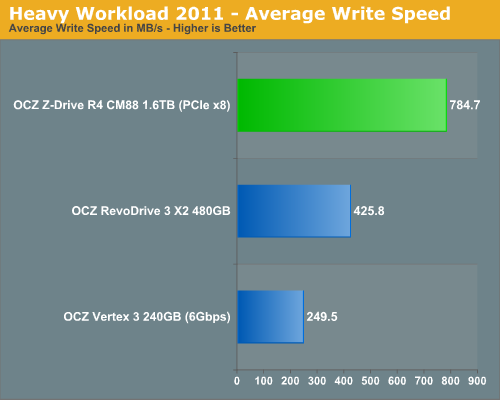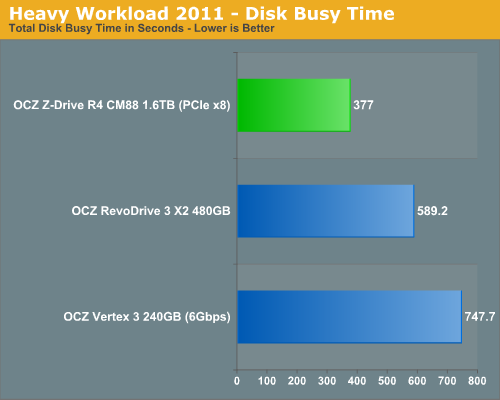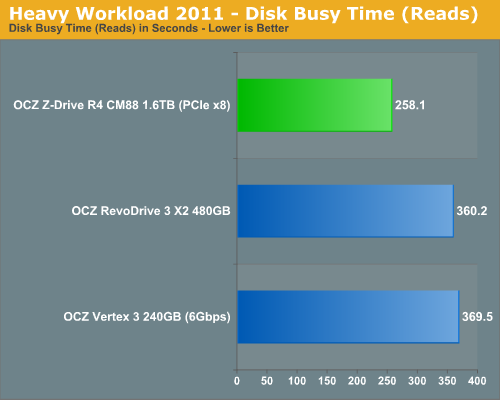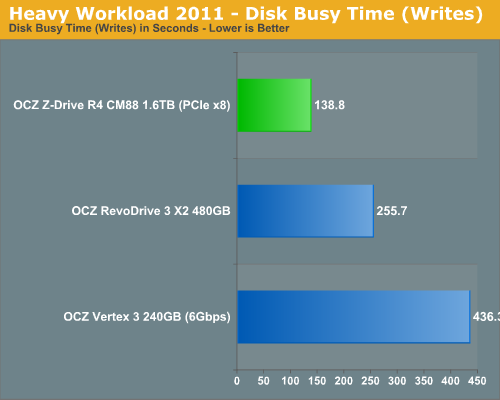OCZ Z-Drive R4 CM88 (1.6TB PCIe SSD) Review
by Anand Lal Shimpi on September 27, 2011 2:02 PM EST- Posted in
- Storage
- SSDs
- OCZ
- Z-Drive R4
- PCIe SSD
AnandTech Storage Bench 2011
Last year we introduced our AnandTech Storage Bench, a suite of benchmarks that took traces of real OS/application usage and played them back in a repeatable manner. I assembled the traces myself out of frustration with the majority of what we have today in terms of SSD benchmarks.
Although the AnandTech Storage Bench tests did a good job of characterizing SSD performance, they weren't stressful enough. All of the tests performed less than 10GB of reads/writes and typically involved only 4GB of writes specifically. That's not even enough exceed the spare area on most SSDs. Most canned SSD benchmarks don't even come close to writing a single gigabyte of data, but that doesn't mean that simply writing 4GB is acceptable.
Originally I kept the benchmarks short enough that they wouldn't be a burden to run (~30 minutes) but long enough that they were representative of what a power user might do with their system.
Not too long ago I tweeted that I had created what I referred to as the Mother of All SSD Benchmarks (MOASB). Rather than only writing 4GB of data to the drive, this benchmark writes 106.32GB. It's the load you'd put on a drive after nearly two weeks of constant usage. And it takes a *long* time to run.
1) The MOASB, officially called AnandTech Storage Bench 2011 - Heavy Workload, mainly focuses on the times when your I/O activity is the highest. There is a lot of downloading and application installing that happens during the course of this test. My thinking was that it's during application installs, file copies, downloading and multitasking with all of this that you can really notice performance differences between drives.
2) I tried to cover as many bases as possible with the software I incorporated into this test. There's a lot of photo editing in Photoshop, HTML editing in Dreamweaver, web browsing, game playing/level loading (Starcraft II & WoW are both a part of the test) as well as general use stuff (application installing, virus scanning). I included a large amount of email downloading, document creation and editing as well. To top it all off I even use Visual Studio 2008 to build Chromium during the test.
The test has 2,168,893 read operations and 1,783,447 write operations. The IO breakdown is as follows:
| AnandTech Storage Bench 2011 - Heavy Workload IO Breakdown | ||||
| IO Size | % of Total | |||
| 4KB | 28% | |||
| 16KB | 10% | |||
| 32KB | 10% | |||
| 64KB | 4% | |||
Only 42% of all operations are sequential, the rest range from pseudo to fully random (with most falling in the pseudo-random category). Average queue depth is 4.625 IOs, with 59% of operations taking place in an IO queue of 1.
Many of you have asked for a better way to really characterize performance. Simply looking at IOPS doesn't really say much. As a result I'm going to be presenting Storage Bench 2011 data in a slightly different way. We'll have performance represented as Average MB/s, with higher numbers being better. At the same time I'll be reporting how long the SSD was busy while running this test. These disk busy graphs will show you exactly how much time was shaved off by using a faster drive vs. a slower one during the course of this test. Finally, I will also break out performance into reads, writes and combined. The reason I do this is to help balance out the fact that this test is unusually write intensive, which can often hide the benefits of a drive with good read performance.
There's also a new light workload for 2011. This is a far more reasonable, typical every day use case benchmark. Lots of web browsing, photo editing (but with a greater focus on photo consumption), video playback as well as some application installs and gaming. This test isn't nearly as write intensive as the MOASB but it's still multiple times more write intensive than what we were running last year.
As always I don't believe that these two benchmarks alone are enough to characterize the performance of a drive, but hopefully along with the rest of our tests they will help provide a better idea.
The testbed for Storage Bench 2011 has changed as well. We're now using a Sandy Bridge platform with full 6Gbps support for these tests. All of the older tests are still run on our X58 platform.
AnandTech Storage Bench 2011 - Heavy Workload
We'll start out by looking at average data rate throughout our new heavy workload test:

I don't expect many desktop/workstation users to buy Z-Drive R4s, but this is the fastest SSD we've tested in our AnandTech Storage Bench 2011 suite. Note the imperfect scaling from 4 to 8 controllers however, the increase over the RevoDrive 3 X2 is only 56%. Even with a strenuous desktop workload it's tough to fully load all 8 controllers in the Z-Drive R4.


The next three charts just represent the same data, but in a different manner. Instead of looking at average data rate, we're looking at how long the disk was busy for during this entire test. Note that disk busy time excludes any and all idles, this is just how long the SSD was busy doing something:













57 Comments
View All Comments
lorribot - Wednesday, September 28, 2011 - link
You cant raid it in software but you could raid several of them if you have deep pockets.The point is why buy a 1.6 or 3.2 TB SSD when you can buy 10 x 320 gb SSDs and (possibly) get better performance for less cost?
bjacobson - Tuesday, September 27, 2011 - link
I think I've mentioned this before but can you load up a Windows 7 installation with 30 or so startup programs and compare the startup time difference between this and a harddrive?A video of this would be be even impressive.
ckryan - Tuesday, September 27, 2011 - link
I've been going through some issues with a 2281 drive with Toggle nand. I'm basically writing 11TB a day to it and under these conditions I can't get too many hours in between crashes. I'm of the opinion that the latest FW has helped most out, but clearly my experience shows that the 2281, when perfected, will be unstoppable in certain workloads, but for now all SF users are going to have some problems. If the problems are predictable you can compensate, but if they're random, well SF controllers aren't the only things that have problem with randomness. I knew it was a possibility, and that normal users won't abuse their drives as much, but I have to wonder if OCZ can make an enterprise drive problem free, why can't they make consumer SF drives better? The SF problem is the OCZ problem... OWC doesn't have the same perception issues, but is using the same hardware (Mushkin,Patriot, etc). As much as I like OCZ, they've done some questionable things in the past, and not just swapping cheap flash in SF1200 drives. Hopefully they can overcome the problems they're having with Sandforce and their Arrowana stuff, release a problem free next gen Indilinx controller, and then call it a day. Oh yeah, quit using those stupid plastic chassis.jalexoid - Tuesday, September 27, 2011 - link
Considering these devices are more likely to find themselves in a machine running something else than a desktop system, why not test them on another OS?sanguy - Wednesday, September 28, 2011 - link
OCZ's standard line "It's only affecting 0.01% of the deployed units and we're working on a fix....." doesn't work in the enterprise market.josephjpeters - Wednesday, September 28, 2011 - link
These are PCIe. Most of the "issues" come from SATA drives because mobo makers are having issues with their SATA ports.p05esto - Wednesday, September 28, 2011 - link
I'll admit, I'm now too lazy to even read....it's getting bad. I just want to push the "play" button while I sit back eating Cheetos and rubbing my tummy. Get into my tummy little Cheeto, get into my brain little ssd review,... same line of thinking really, whatever is easiest.Great review though, seriously.
alpha754293 - Wednesday, September 28, 2011 - link
If you want to really test it'and validate it's long term reliability, you pretty much need to do what enterprise customers do. Run the SSD, but always keep a backup of it somewhere, like you said.That being said though, if you've got TWO backup copies of it, you can actually run a parity check on it (pseudo-checksum) and determine its error rate.
Also, you didn't run HDTach on it. Given that it's tied together with a Marvell SAS controller, NOT being able to run TRIM on it, I would presume, will give it performance issues in the long run.
To do the error checking, you'll probably have to put this thing in a Solaris system running ZFS so you can mimic the CERN test. And if you actually read/write continuously to it, at the same level in terms of the sheer volume of data, other SSD/NAND-specific issues might start to pop up like wear levelling, etc. I would probably just run the read/write cycle for an entire month, where it periodically deletes some data, rewrite new data, etc. At the end of the month, make the two mirror backups of it. And then run it again. Hopefully you'd be able to end up at some identical endpoint after PBs of read/write ops that you can run both the block level and volume level checksum on.
But as a swap drive, this would be BLAZINGLY fast.
perrydoell - Wednesday, September 28, 2011 - link
You say "We have a preproduction board that has a number of stability & compatibility issues."This is the enterprise space. Things MUST WORK RELIABLY. How can you even review unstable products? I expect better from Anandtech.
I cannot take OCZ seriously either. An unstable product is NOT for the enterprise. Also, check the negative reviews at NewEgg. Ouch.
josephjpeters - Wednesday, September 28, 2011 - link
Where is the R4 listed on Newegg?